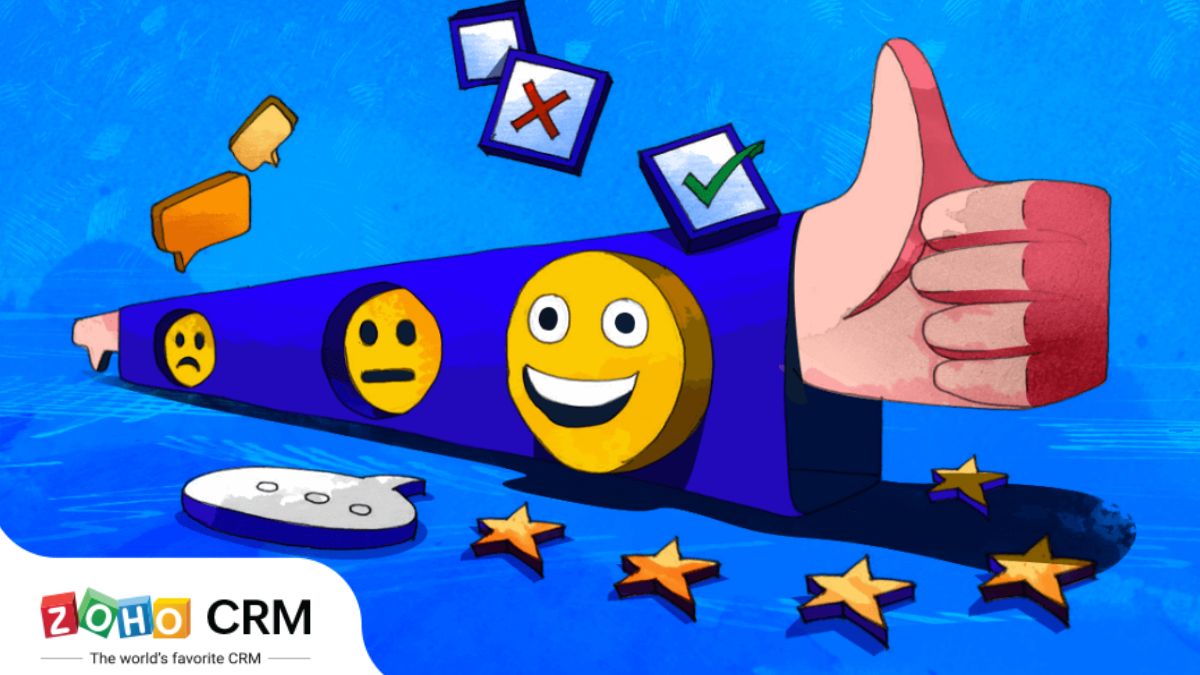- HOME
- Management
- How to get a sense of your emails before you open them
How to get a sense of your emails before you open them
- Last Updated : August 7, 2023
- 286 Views
- 5 Min Read

An inbox can be a cluttered and busy place sometimes. Every day, you receive internal emails, newsletters, marketing content, notifications, and more, with only a fraction being conversational exchanges with colleagues, contacts, customers, and leads. Templafy reports that an average office worker receives 121 emails a day, which brings us to two conclusions:
- To read and respond to every email is an impossible task.
- I’m a below average office worker.
Conversing with customers and leads can be a time-intensive task. It’s hard to prioritise without opening and reading every email. That’s why we’re going to take a look at the future of your inbox: sentiment analysis
Emails carry sentiment
Humans inherently display emotion in everything we write, and that includes our emails. Even if you aren’t consciously picking a tone or voice to write in, it will still be reflected in your natural choice of words and phrases. Most importantly, this applies to professional emails, too—your customers may not know you personally, but their writing will display their emotions, nonetheless.
Based on the sentiments found in your various emails, you can prioritize which of them deserve a response sooner than the others. You’ll aggravate an angry customer filing a complaint if you respond to them too late, but a happy customer who leaves warm feedback won’t mind as much to wait for a reply. Every email from a customer or lead is important, but it’s crucial to your work to prioritize which ones are more important than the others.
While you may improve your customer satisfaction by going through your new emails and prioritizing them, how can it help you save time? After all, you’d have to read every single email to do it properly, right?
How about having an AI do it?
Lately, Artificial Intelligence seems to be the answer for every productivity problem we have. Although the golden age of AI is still ahead of us, Zoho is taking us closer every day. Out of the many accomplishments made by AI, one of the most remarkable is the ability to read, identify, and comprehend emotions.
As of now, computers may not feel emotions with the depth that humans do, but they can definitely tell emotions apart. Notably, BeyondVerbal developed an AI that can detect emotions based on the sound of a person’s voice, and recently, a study made by the Proceedings of the National Academy of Sciences found that AI can read facial expressions to identify emotions better than humans.
Frontapp reports that an average office worker spends about 28% of their work-week on emails (more than 11 hours a week), labor which could be greatly reduced by prioritising emails based on sentiments, with a bit of assistance from AI.
How can AI detect emotion in text?
There’s no revolutionary algorithm that’s going to blow your mind—AI identifies emotions in much the same way a human would. Let’s say you receive an email saying, “I’m afraid that we simply can’t afford the prices you quoted us. I’d be happy to negotiate further if you’re still interested!”. Of course, you likely know that this is a negative email. But how were you able to tell? Easy—the lead is “afraid” that they “can’t afford” the price you quoted. You were able to tell it’s negative because you identified the negative words used in the message. Even though the word “happy” comes later in the next sentence, the overall negativity of the meaning and tone outweighed the token positivity.
That’s a simplified version of the science behind an AI-based sentiment analysis system—the computer looks for words or phrases that convey different emotions, aggregates them, and draws a conclusion as to what the overall emotion is. Initially, the AI is fed with a list of positive and negative text fragments, and trains on a series of sample cases. Once the training is done, the AI can be deployed to read your inbox and mark emails as either positive or negative, overall.
AI improves over time!
You can help the AI do its job better by manually correcting their work. Whenever the AI gets a prediction wrong, you can let it know. Like humans, even machines learn from their mistakes. Over time, the AI gets better at prediction through practice with a trial-and-error process; and with a massive test environment of the world’s email users, the AI can fine-tune its skills with incredible speed!
Every industry has its own internal lingo and jargon—words, not commonly used outside of the group. However, if these terms are used regularly in your emails, you can manually teach the AI those uncommon words and the sentiment or emotion they convey (think “layoffs” vs “upward mobility”). That way, your AI-based predictions would not only be more accurate but also more relevant to your work.
Intrigued? Check out Zia!
If you’re wondering where you can find such a sophisticated AI for your own inbox, look no further! Zia, the AI assistant that powers Zoho CRM, is just the software for you. If you’re an existing user of Zoho CRM, or you’re simply looking for a novel email solution, check out the details of Zia’s sentiment analysis here.
Zia marks all your emails with either a “happy” or “sad” icon, as shown in the image below, based on whether the email is positive or negative. This way, you can find out the emotion attached to an email before you even open it. You can filter for positive or negative emails, add your own jargon to Zia’s vocabulary, and even add your own data to the training module to help Zia improve their predictions.
So, how do you benefit from Zia?
Prioritise emails: When you know how each customer is feeling when you take a look at the list of emails in your inbox, you’ll know which emails require your attention sooner than others, helping you prioritize without the need for a lot of reading.
Close deals faster: When a lead sends a positive email, you’ll be instantly notified. Happy emails are a sign that you’re near to closing a deal, so you can quickly follow up with them and win their business.
Retain customers: When an angry customer shows their dissatisfaction in an email, you know it’s code red. Thanks to Zia, you’ll get to know about it on the go, allowing you to reach out to them in time to change their tune.
Assign the right talent: Positive emails are sometimes better handled by one team, and negative emails are better handled by another. Is it a question about your product? Are they reporting an issue? Or is it just general feedback? When you know the emotional quality of every email, you can assign them to the right talent.
Zia can do more than just identify emotions in an email—she’s a conversational AI, like Siri and Alexa, but built with salespeople and their everyday activities in mind. Learn more about what she can do for you and your business here.
Keeping your customers’ emotions at the heart of your service is what helps a business stand out from the crowd. If your competitors have the same technology, features, and pricing as you, why should people choose to do business with you? Personalised customer service—delivered on time, with empathy and value—will set you apart from the crowd.


